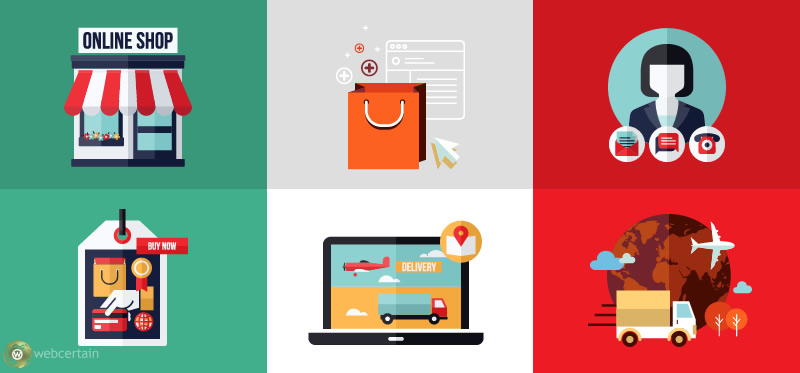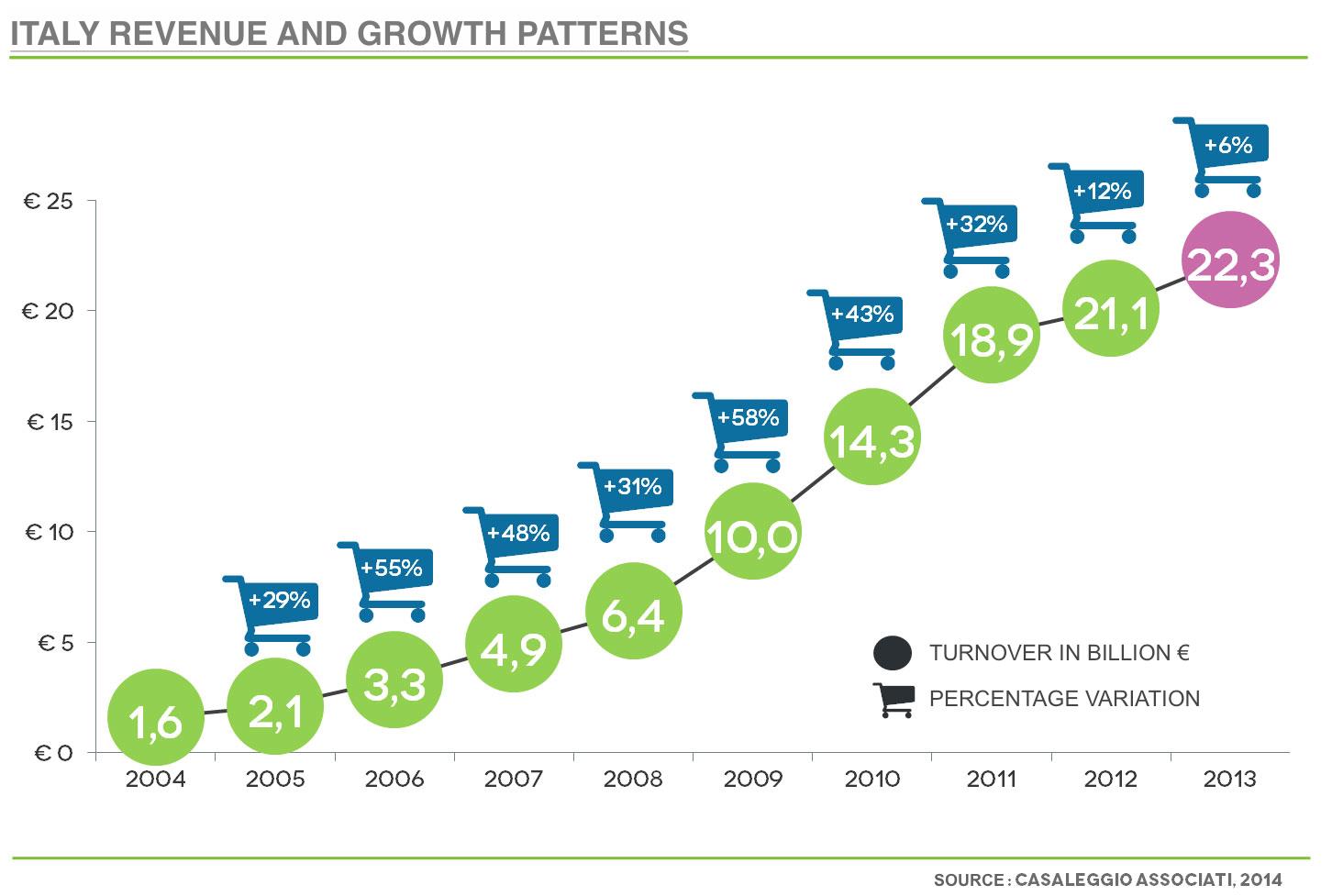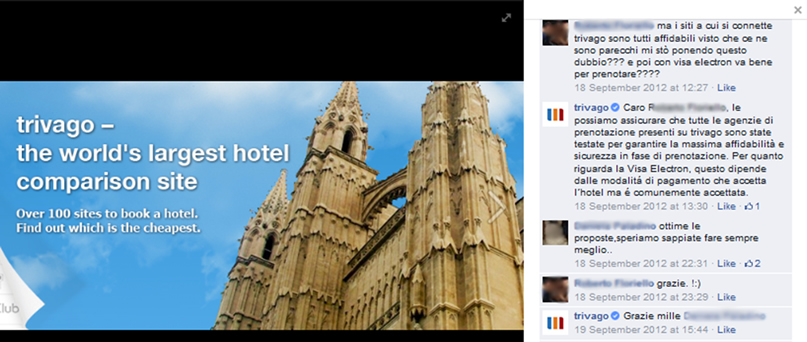 Italy currently ranks fifth in online retail sales in Europe, trailing the U.K., Germany, France and Spain, with approximately €6 billion in retail online sales last year and a growth rate of 9% or higher every year. It is expected to surpass other leading European countries in the coming years, approaching €10 billion online sales per year by 2018, meaning that Italy has emerged as one of the major target markets for online retail brands looking to expand into new countries.
Italy currently ranks fifth in online retail sales in Europe, trailing the U.K., Germany, France and Spain, with approximately €6 billion in retail online sales last year and a growth rate of 9% or higher every year. It is expected to surpass other leading European countries in the coming years, approaching €10 billion online sales per year by 2018, meaning that Italy has emerged as one of the major target markets for online retail brands looking to expand into new countries.
With the buying process becoming less and less linear, it is vital to build an integrated digital marketing strategy that takes care of the cultural search behaviors and consumers approach to shopping.
So What Should Online Retailers Know About E-commerce in Italy?
There are approximately 15 million “digital buyers” in Italy, which means only 25% of the population (60 million people) made at least one online purchase in the past year. Online retail sales currently make up 1.4% of all retail sales in Italy but are expected to reach 2% by 2018. Despite the fact these percentages are lower than many leading European countries, the e-commerce revenue growth percentage is increasing consistently, year by year from 2004, and it is expected to rise to around 34% by the end of 2018.
With more Italians going online and choosing to experience online retail for the first time, there are some unique opportunities for online retail brands to reach Italian consumers and their digital shopping experiences.
 With a growing income disparity and the increasing unemployment rate, the Italian market still proves a struggle for lower-end products online but, on the other hand, the unique demand for high-end products online is driving niche online retailers to have the most success, especially those selling products appealing to younger Italian consumers who are more likely to shop online.
With a growing income disparity and the increasing unemployment rate, the Italian market still proves a struggle for lower-end products online but, on the other hand, the unique demand for high-end products online is driving niche online retailers to have the most success, especially those selling products appealing to younger Italian consumers who are more likely to shop online.
40% of Italian consumers declare they don’t feel comfortable with online e-commerce platforms. Sales in the country are generally driven by a cash reliant culture although a recent survey shows that the 52% of Italian would like to use online purchase methods in the future. This percentage is actually higher than 41% of French and 40% of British consumers.
What can be done to draw more Italian shoppers online?
Offer Online Discounts
87% of consumers prefer to buy in shops after searching online, so online retailers need to make online purchasing more attractive, in order to tempt Italian shoppers away.
This tendency also known as ROPO (Research Online Purchase Offline) is slowly being overtaken by showrooming (product browsing in store and buy them online) thanks to the spread of new mobile technologies like the smartphones.
In fact 55.9% of Italian shoppers admit that they check their smartphones once they are inside a shop to see if the product they want to buy is available online at a discounted or lower price and 65% declare they will be willing to leave the store if they would find the same product online with a 5% difference in price.
This percentage increases to 96% of shoppers if the discount price was 20%.
Target Different Age Groups
It is also interesting to observe that the age disparity in Italy is changing. Research has shown that 62.2% of over 55’s made an online purchase in the last 3 months. This percentage is slightly less than 35-45 and 25-34 age groups of 72.7% and 76.1% respectively but still represents a significant number, in a demographic that might be overlooked.
However showrooming is gradually getting popular among the younger consumers, it has shown to be 78.2% between the 25-34 year old and 69.8% between the 45-54 years old.
%GC_SERVICE=1959%
Create a Synergy Between the Online and Offline World
In order to improve the online purchasing experience it is important to have a look at the Italian consumers feedback. A recent survey has shown that:
83.2% would appreciate receiving special offers and vouchers directly on their mobile devices once they enter a shop, 79.3% would welcome the opportunity to check remotely the availability of a product in store, 70% would like the opportunity to use their smartphone to reduce payment transaction times like queuing at the till and 67% feel it would be beneficial to be able to have access to a digital map helping them in localising products in store.
Physical locations and stores remain a strong point of sale for Italians, 69.5% choose to shop in store because of the opportunity to check the products in person with 51.8% valuing the chance to rely on face to face interactions and expertise of the shop assistants.
Retailers who can combine the offline and online worlds and offer a more interactive experience for customers in their physical stores could really see the benefits.
Embrace Social Media
One interesting detail is the role of Social Networks, Facebook (47%) and YouTube (25.4%) Google+ (23.8%) and Twitter (11.9%), in influencing the shop behaviour of Italians.
Social media is crucial to create brand awareness. In Italy, social content able to drive a user to visit a particular shop or to buy a specific brand are:
Promotions 64.9%
Posts by friends 57.3%
Adverts 55.3%
39.7% use social media to inform others of their latest purchases particularly when they are convinced they’ve got a good deal or received a good offer and 38.2% post simply to inform their friends about what they’ve bought.
Although we are still in the early stages of establishing a direct connection between social media and sales, in countries like Italy where engaging with potential clients is vital in order to drive them to the final purchase, social media could be of great help in terms of customer care, segmentation and data acquisition. Trivago, for example, used Facebook in Italy to implement their customer service, with the 25% of queries dealt with via the platform. The company stated that Facebook helped customers understanding there are real people behind the brand.
In conclusion, the key to engaging Italians into online activities is to understand their needs and desires when making a purchase and optimise e-commerce platforms to deliver as much of this as possible, making sure websites don’t suffer from any linguistic or cultural problems that could be off-putting to potential customers. A social media presence will clearly add value and it is also crucial to develop a mobile version of your website, using apps to differentiate the online shopping experience from the one in store. To push this further, brands could use techniques like retargeting, location–based advertising and mobile couponing to connect with the target audience and stand out from the crowd.










